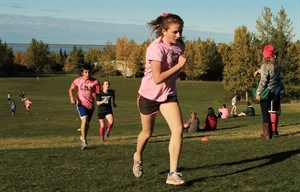
HOLD FOR RELEASE UNTIL WEDNESDAY, JAN. 8, 2014 AT 12:01 A.M. EST. THIS STORY MAY NOT BE PUBLISHED, BROADCAST OR POSTED ONLINE BEFORE WEDNESDAY, JAN. 8, 2014 AT 12:01 A.M. EST - FILE - Central and Mirror Lake Middle School cross-country runners, wearing pink for breast cancer awareness, climb the final hill of a cross-country race at Kincaid Park in Anchorage, Alaska on Tuesday, Oct. 1, 2013. According to the Centers for Disease Control and Prevention, only 1 in 4 U.S. kids aged 12 to 15 meet the recommendations of an hour or more of moderate to vigorous activity every day. The CDC released partial results Wednesday, Jan. 8, 2014 from a fitness survey, which involved kids aged 3 to 15. (AP Photo/Dan Joling)
January 07, 2014 - 11:47 PM
CHICAGO - Young teens aren't exactly embracing the government's Let's Move mantra, the latest fitness data suggest.
Only 1 in 4 U.S. kids aged 12 to 15 meet the recommendations — an hour or more of moderate to vigorous activity every day.
The results are based on about 800 kids who self-reported their activity levels and had physical exams as part of the 2012 National Youth Fitness Survey.
Government researchers won't call the results disappointing, but lead author Tala Fakhouri of the Centers for Disease Control and Prevention said, "There's always room for improvement."
The CDC released partial results Wednesday from the fitness survey, which involved kids aged 3 to 15. Other results from the same survey are pending and include fitness data based on more objective measures including treadmill tests.
Fakhouri said the nationally representative results provide useful information for initiatives that aim to increase kids' fitness, including the Let's Move anti-obesity campaign launched by first lady Michelle Obama in 2010.
Kids in the survey reported on which physical activities they did most frequently outside of school gym class — basketball for boys and running for girls.
While few met guidelines established in 2008 for activity that raises the heart rate and makes you breathe harder, most said they did at least an hour of exercise at that level during the previous week. Overall, about 25 per cent said they got an hour of that kind of exercise every day
Obese kids were less active than normal-weight girls and boys. Overweight girls were slightly less active than normal-weight girls, but levels were similar among overweight and normal-weight boys.
"It's definitely very concerning to see that our kids are engaging in such a limited amount of physical activity each day when we are still battling" an obesity epidemic, said Dr. Stephen Pont, an Austin, Texas, pediatrician and chairman of the American Academy of Pediatrics' section on obesity.
Data suggest obesity may have decreased slightly among some kids but the overall rate for children aged 2 to 19 is 17 per cent, or about 12.5 million obese kids.
Pont said schools can do more to help by not cutting recess and giving kids more time for physical activity. He said research suggests kids who get physical education at school may do better academically.
Recent national data on kids' fitness levels is limited. A 2009-10 CDC survey involving kids ages 6 to 11 found about 70 per cent met the physical activity guidelines, although levels dropped off among older kids in that age group. The results came from parents, who may be inclined to over-report how active their kids are because of "social desirability," the researchers said.
___
Online:
CDC: http://www.cdc.gov
___
AP Medical Writer Lindsey Tanner can be reached at http://www.twitter.com/LindseyTanner
News from © The Associated Press, 2014